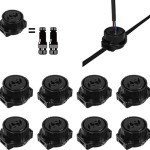How to Build an Outdoor Wood-Fired Oven
Building an outdoor wood-fired oven can be a rewarding DIY project, offering a unique cooking experience and a focal point for outdoor gatherings. This guide provides a comprehensive overview of the construction process, outlining the necessary materials, tools, and steps involved.
Planning and Preparation: Careful planning is crucial for a successful build. Begin by selecting a suitable location, considering proximity to the house, prevailing winds, and local fire codes. A concrete slab foundation is recommended for stability and safety. Draft a detailed plan, including dimensions and material specifications, to ensure accurate material procurement and construction.
Materials: The primary materials required include firebricks, refractory mortar, concrete, sand, gravel, insulation (such as vermiculite or perlite), and exterior cladding materials (e.g., brick, stone, stucco). Other necessary materials include metal rebar, wire mesh, a door frame (optional), and a chimney flue.
Tools: Essential tools for this project include a shovel, trowel, level, measuring tape, wheelbarrow, concrete mixer (optional but recommended), brick saw or angle grinder with a diamond blade, safety glasses, gloves, and dust mask.
Building the Foundation: Excavate the area for the foundation to the required depth, typically around 12 inches. Construct a wooden formwork to contain the concrete pour. Place a layer of compacted gravel at the base of the excavation for drainage. Reinforce the foundation with rebar and wire mesh. Pour the concrete mixture into the formwork, ensuring it is level and evenly distributed. Allow the concrete to cure completely, typically 28 days, before proceeding to the next step.
Constructing the Oven Base: Create a solid base using concrete blocks or bricks laid with mortar. This base elevates the oven to a comfortable working height. Ensure the base is level and provides a stable platform for the oven floor.
Building the Oven Floor: Lay a layer of firebricks over the oven base, using refractory mortar to join them. Ensure the floor is level and provides a flat surface for cooking. Consider incorporating a slight slope towards the oven opening to facilitate drainage.
Forming the Oven Dome: The oven dome can be constructed using several methods. One common approach involves creating a temporary sand form, packing damp sand into the desired dome shape. Alternatively, a cardboard template can be used to guide the bricklaying process. Lay the firebricks over the sand form or template, using refractory mortar to secure them. Leave a small opening at the front for the oven entrance.
Insulating the Oven: Insulation is crucial for retaining heat and improving the oven's efficiency. Apply a thick layer of insulating material, such as vermiculite or perlite mixed with refractory cement, around the oven dome. This layer helps to maintain high temperatures within the oven and reduces heat loss to the surrounding environment.
Applying the Exterior Cladding: The exterior cladding provides weather protection and enhances the oven's aesthetic appeal. Common cladding materials include brick, stone, or stucco. Apply the chosen material over the insulation layer, adhering it with appropriate mortar or adhesive.
Building the Oven Door and Chimney (Optional): An oven door helps to retain heat and control the cooking environment. Construct a door frame using metal or brick and install a metal door with a handle. A chimney flue can be added to improve ventilation and direct smoke away from the cooking area. Construct the chimney using firebricks and mortar, ensuring it is securely attached to the oven dome.
Curing the Oven: After construction, the oven needs to be cured slowly to prevent cracking. Build small fires over several days, gradually increasing the fire size and duration. This process allows the moisture in the mortar and bricks to evaporate slowly, strengthening the oven structure.
Maintenance: Regular maintenance is essential to prolong the lifespan of the wood-fired oven. Remove ashes after each use. Inspect the oven structure periodically for cracks or damage. Repair any damage promptly using refractory mortar. Protect the oven from the elements with a waterproof cover when not in use.
Safety Considerations: Always prioritize safety when operating a wood-fired oven. Use heat-resistant gloves and protective eyewear when handling hot materials. Keep a fire extinguisher nearby and ensure adequate ventilation in the surrounding area. Never leave the oven unattended while in use. Consult local fire codes and regulations before construction and operation.

How To Build A Simple Wood Fired Oven

Build Your Own Oven Patio Outdoor Furnishings

20 Design Ideas For Your Outdoor Wood Fired Oven Kit Forno Bravo Authentic Ovens

How To Build A Simple Wood Fired Oven

How To Build Our Wood Fired Brick Oven Kit

Diy Wood Fired Outdoor Oven Simple Earth In 2 Days

How To Build An Outdoor Oven

How To Build A Diy Wood Fired Oven

How To Build A Wood Fired Oven Delicious

Diy Outdoor Wood Fired Pallet Oven







